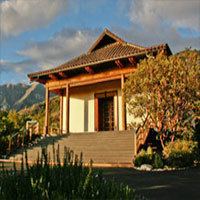State California | ||
 | ||
Website Vedanta Temple, Santa Barbara Architectural style Early South Indian wooden style Similar Casa del Herrero, Lobero Theatre, Knott's Berry Farm, Universal Studios Hollywood, Guardians of the Galaxy | ||
Rabindra s 8mm films santa barbara vedanta temple
Built and dedicated in 1956, the Santa Barbara Vedanta Temple is located on a 45-acre property situated between the foothills above the City of Santa Barbara, and below the peaks of the Santa Ynez Mountains. The temple has a clear view overlooking the Pacific ocean and the Channel Islands of California.
Contents
The Vedanta Temple is part of the Vedanta Society of Southern California and is a Western branch of the Ramakrishna Order of India.
Facilities & Activities
Facilities adjacent to the temple include; a bookstore, a shaded sitting area for congregating after services, and a 12th-century Japanese-cast temple bell (which was once fastened to a Chinese military ship) that is rung three times per day at dawn, noon, and dusk. A path behind the temple leads up a hill to a pavilion where classes are held with the swamis and the nuns.
The temple is open daily to the public. A convent of nuns manage the bookstore, oversee maintenance of the grounds, and facilitate the temple's public activities; including daily worship (i.e. Puja), meditation, and vesper services (i.e. Arati). There are also regular Sunday lectures and pujas.
The temple hours run from 6:30 am to 7:00 pm every day with a daily puja, and arati at 6:00 pm. Sunday lectures are at 11:00 am. The bookstore is open Monday through Saturday (except on Wednesdays) from 11:00 am to 5:00 pm, and on Sundays from 10:00 am to 1:00 pm.
The inner sanctum of the temple is adorned with a 44" x 50" oil on canvas painting of the Indian Paramahansa and yogi Sri Ramakrishna, painted by Swami Tadatmananda (1932-2008) in 1962.
History
The temple was built on a mostly undeveloped estate donated by Spencer Kellogg to the Vedanta Society of Southern California in 1944. The property was largely covered with thick chaparral shrub, and included a house, a small shrine building, and an art room. It has been published that Spencer Kellogg offered the property on two occasions to Swami Prabhavananda (founder of the Vedanta Society of Southern California), but was turned down due to the Swami's concern for possible financial imprudence or solecism. However, he eventually changed his mind on the following account:
"But having overheard Kellogg speaking to himself about his grand plan while he swept the path near the shrine–along with an endowment of a lemon orchard–the monk decided it was indeed divinely given. 'Okay,' said Prabhavananda, 'we’ll take it.'"
Initially the property was used as a retreat for monks, nuns, and lay members of the Vedanta Society in Hollywood. From 1946-47, a retired contractor and a group of monks constructed four bedrooms surrounding the art room. In 1947, the estate was then designated as a full-time convent for a group of nuns from the Hollywood Center. The first monastic vows were given to three of the convent members.
In 1954, the first public lectures were given in the living room of the main house. It was soon determined that a temple was needed to accommodate some seventy regular attendees. The temple was constructed and dedicated in 1956.
In 1959, the temple became the venue for taking the vows of sannyas for women in America for the first time by the Ramakrishna Order of India.
Architecture
The temple was designed by Lutah Maria Riggs (1896-1984) who styled the structure after the ancient wooden temples of South India, along with Japanese and Chinese architectural styles. Surrounding the temple there are rock gardens with native plant species, which were landscaped by Riggs with guidance from renown architect Frank Lloyd Wright. Serving as an example to international architects, the building has received several awards for its design.
The temple has thus been described:
"Its peaked structure is supported by processions of golden-hue wood columns that were formerly telephone poles made from Oregon pine trees. They are complemented by graceful laminated arches, Indonesian carvings, brass lamps, and a broad Egyptian screen near the entry. Frank Lloyd Wright, who had met [Swami] Prabhavanada, was an early visitor and great admirer of the temple’s interior design."
Riggs had also designed the temple lanterns (1960) and other structures on the temple grounds, including the gatehouse (1958–59, 1963), a carport (1960), the pavilion (1960, 1964–65), and the Eva Herrmann House (1968–70). Years later she conveyed that initially she had a limited grasp of oriental architecture before delving into various literature on the topic, which included; "Japanese Houses and their Surroundings" by Edward S. Morse (published 1886), and "Impressions of Japanese Architecture" by Ralph Adams Cram (published 1905), as well as other literature on Chinese and Japanese landscape architecture, including "Gardens of China" by Osvald Sirén (published 1949)
An architectural analysis describes the temple as a work of both traditionalism and modernism:
"The gabled, sweeping roofed temple was placed on a low-raised platform and was approached from the south by a bank of stairs. The tiled roof was projected far out from the walls and was supported by paired rafters. The vertical log posts supported the exposed lintel and roof were left partially exposed within the white plastered wall surfaces. This rhythmic effect encourages one to respond to the building as being derived from traditionalist concepts, as well as those of the modernist. As with her earlier Hispanic designs and her postwar modernist design, Riggs looked to the theme of carefully thought out simplicity to create an abstracted version of a traditional form."
